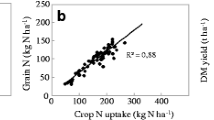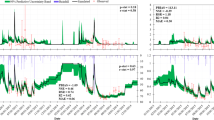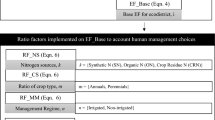Abstract
The global warming potential of nitrous oxide (N2O) and its long atmospheric lifetime mean its presence in the atmosphere is of major concern, and that methods are required to measure and reduce emissions. Large spatial and temporal variations means, however, that simple extrapolation of measured data is inappropriate, and that other methods of quantification are required. Although process-based models have been developed to simulate these emissions, they often require a large amount of input data that is not available at a regional scale, making regional and global emission estimates difficult to achieve. The spatial extent of organic soils means that quantification of emissions from these soil types is also required, but will not be achievable using a process-based model that has not been developed to simulate soil water contents above field capacity or organic soils. The ECOSSE model was developed to overcome these limitations, and with a requirement for only input data that is readily available at a regional scale, it can be used to quantify regional emissions and directly inform land-use change decisions. ECOSSE includes the major processes of nitrogen (N) turnover, with material being exchanged between pools of SOM at rates modified by temperature, soil moisture, soil pH and crop cover. Evaluation of its performance at site-scale is presented to demonstrate its ability to adequately simulate soil N contents and N2O emissions from cropland soils in Europe. Mitigation scenarios and sensitivity analyses are also presented to demonstrate how ECOSSE can be used to estimate the impact of future climate and land-use change on N2O emissions.









Similar content being viewed by others
Abbreviations
- \( C_{{{\text{CO}}_{2} }} \) :
-
The amount of CO2 produced during mineralization (kg C ha−1 day−1)
- C max :
-
A constant (set at 50 kg N ha−1) that adjusts the maximum rate of nitrification possible [this occurs at high levels of NH4 + and will be dependent on soil composition (Parton et al. 1996)]
- D p :
-
Potential denitrification rate (kg N ha−1 layer−1 day−1)
- k nitrif :
-
A rate constant for nitrification [set at 0.6 (Bradbury et al. (1993)]
- m b :
-
Biological activity rate modifier
- \( m_{{{\text{NO}}_{3} }} \) :
-
Modifies the amount of denitrification depending on soil NO3 − content
- m pH :
-
A rate modifier due to soil pH
- m t :
-
A rate modifier due to soil temperature
- m w :
-
Soil water rate modifier for decomposition
- m w0 :
-
Soil water rate modifier for decomposition at permanent wilting point and saturation = 0.2
- \( m_{\text{w}}^{\prime } \) :
-
Soil water rate modifier for denitrification
- N d :
-
The amount of N emitted from the soil during denitrification (kg N ha−1 layer−1)
- \( N_{{{\text{d}},{\text{N}}_{2} }} \) :
-
The amount of N2 gas lost by denitrification (kg N ha−1 day−1)
- \( N_{{{\text{d}},{\text{N}}_{2} {\text{O}}}} \) :
-
The amount of N2O gas lost by denitrification (kg N ha−1 day−1)
- N d50 :
-
The soil nitrate content at which denitrification is 50% of its full potential (kg N ha−1 layer−1)
- N FERT :
-
N in NH4 + and urea in the added fertiliser (kg N ha−1)
- N n :
-
Nitrification rate (kg N ha−1 layer−1)
- \( N_{{{\text{n}},{\text{N}}_{2} {\text{O}}}} \) :
-
The amount of N2O gas released during nitrification (kg N ha−1 day−1)
- \( N_{{{\text{NH}}_{4} }} \) :
-
The amount of NH4+–N in the soil (kg N ha−1 layer−1)
- \( N_{{{\text{NO}}_{3} }} \) :
-
The amount of NO3 −–N in the soil (kg N ha−1 layer−1)
- n f :
-
The proportion of N2O produced due to partial nitrification at field capacity = 0.02
- n gas :
-
The proportion of full nitrification lost as gas = 0.02
- n NO :
-
The proportion of full nitrification gaseous loss that is NO = 0.4
- pH:
-
Soil pH
- \( p_{{{\text{N}}_{2} , {\text{f}}}} \) :
-
The proportion of denitrified N lost as N2 at field capacity = 0.5
- \( p_{{{\text{NO}}_{3} }} \) :
-
Proportion of denitrified gas emitted as N2 according to the NO3 − content of the soil
- \( p_{{{\text{NO}}_{3} ,{\text{f}}}} \) :
-
The parameter that denotes the NO3 − content of the soil at which N is released in equal quantities of N2 and N2O in the denitrification process (kg N ha−1 layer−1)
- p w :
-
Proportion of denitrified gas emitted as N2 according to the water content of the soil
- T air :
-
Air temperature (°C)
- θc :
-
The amount of water in a particular soil layer above the permanent wilting point (mm layer−1)
- θf :
-
The amount of water held between field capacity and the permanent wilting point (mm layer−1)
- θs :
-
The water content between saturation and wilting point (mm layer−1)
- φi :
-
Soil moisture deficit at the permanent wilting point (at −100 kPa) (mm layer−1)
References
Abdalla M, Wattenbach M, Smith P, Ambus P, Jones M, Williams M (2009) Application of the DNDC model to predict emissions of N2O from Irish agriculture. Geoderma 151:327–337
Abdalla M, Jones M, Yeluripati J, Smith P, Burke J, Williams M (2010) Testing DayCent and DNDC model simulations of N2O fluxes and assessing the impacts of climate change on the gas flux and biomass production from a humid pasture. Atmos Environ 44:2961–2970
Babu YJ, Li C, Frolking S, Nayak DR, Adhya TK (2006) Field validation of DNDC model for methane and nitrous oxide emissions from rice-based production systems of India. Nutr Cycl Agroecosyst 74:157–174
Beheydt D, Boeckx P, Sleutel S, Li C, Van Cleemput O (2007) Validation of DNDC for 22 long-term N2O field emission measurements. Atmos Environ 41:6196–6211
Bouwman AF, Stehfest E, Vankessel C (2010) Nitrous oxide emissions from the nitrogen cycle in arable agriculture: estimation and mitigation. In: Smith K (ed) Nitrous oxide and climate change. Earthscan, London, pp 1–240
Bradbury NJ, Whitmore AP, Hart PBS, Jenkinson DS (1993) Modelling the fate of nitrogen in crop and soil in the years following application of 15 N-labelled fertiliser to winter wheat. J Agric Sci 121:363–379
Brown L, Armstrong Brown S, Jarvis SC, Syed B, Goulding WT, Phillips VR, Snenth RW, Pain BF (2001) An inventory of nitrous oxide emissions from agriculture in the UK using the IPCC methodology: emission estimate, uncertainty and sensitivity analysis. Atmos Environ 35:1439–1449
Ceschia E et al (2010) Management effects on net ecosystem carbon and GHG budgets at European crop sites. Agric Ecosyst Environ 139:363–383
Chatskikh D, Olesen J, Berntsen J, Regina K, Yamulki S (2005) Simulation of effects of soils, climate and management on N2O emissions from grasslands. Biogeochemistry 76:395–419
Clayton H, McTaggart IP, Parker J, Swan L, Smith KA (1997) Nitrous oxide emissions from fertilized grassland: a 2-year study of the effects of N fertilizer form and environmental conditions. Biol Fertil Soils 25:252–260
Del Grosso SJ, Parton WJ, Mosier AR, Hartman MD, Keough CA, Peterson GA, Ojima DS, Schimel DS (2001) Chapter 16: Simulated effects of land-use, soil texture, and precipitation on N gas emissions using DAYCENT. In: Follett RF, Hatfield JL (eds) Nitrogen in the environment: sources, problems, and management. Elsevier, The Netherlands, pp 413–432
Del Grosso SJ, Mosier AR, Parton WJ, Ojima DS (2005) DAYCENT model analysis of past and contemporary soil N2O and net greenhouse gas flux for major crops in the USA. Soil Tillage Res 83:9–24
Del Grosso SJ, Halvorson AD, Parton WJ (2008) Testing DAYCENT model simulations of corn yields and nitrous oxide emissions in irrigated tillage systems in Colorado. J Environ Qual 37:1383–1389
Del Grosso SJ, Ojima DS, Parton WJ, Stehfest E, Heistemann M, DeAngelo B, Rose S (2009) Global scale DAYCENT model analysis of greenhouse gas emissions ad mitigation strategies for cropped soils. Glob Planet Change 67:44–50
Desjardins RL, Pattey E, Smith WN, Worth D, Grant B, Srinivasan R, MacPherson JI, Mauder M (2010) Multiscale estimates of N2O emissions from agricultural lands. Agric For Meteorol 150:817–824
Dobbie KE, Smith KA (2006) The effect of water table depth on emissions of N2O from a grassland soil. Soil Use Manag 22:22–28
Flynn HC, Smith J, Smith KA, Wright J, Smith P, Massheder J (2005) Climate- and crop-responsive emission factors significantly alter estimates of current and future nitrous oxide emissions from fertiliser use. Glob Change Biol 11:1522–1536
Frolking SE et al (1998) Comparison of N2O emissions from soils at three temperate agricultural sites: simulations of year-round measurements by four models. Nutr Cycl Agroecosyst 52:77–105
Gabrielle B, Mary B, Roche R, Smith P, Gosse G (2002a) Simulation of carbon and nitrogen dynamics in arable soils: a comparison of approaches. Eur J Agron 18:107–120
Gabrielle B, Roche R, Angas P et al (2002b) A priori parameterisation of the CERES soil-crop models and tests against several European data sets. Agronomie 22:119–132
Giltrap D, Saggar S, Li C, Wilde H (2008) Using the NZ-DNDC model to estimate agricultural N2O emissions in the Manawatu-Wanganui region. Plant Soil 309:191–209
Giltrap DL, Li C, Saggar S (2010) DNDC: a process-based model of greenhouse gas fluxes from agricultural soils. Agric Ecosyst Environ 136:292–300
Grundmann GL, Rolston DE (1987) A water function approximation to degree of anaerobiosis associated with denitrification. Soil Sci 144:437–441
Hastings A, Wattenbach M, Eugster W, Li C, Buchmann N, Smith P (2010) Uncertainty propagation in soil greenhouse gas emission models: an experiment using the DNDC model and at the Oensingen Cropland site. Agric Ecosyst Environ 136:97–110
Henault C, Germon JC (2000) NEMIS, a predictive model of denitrification on the field scale. Eur J Soil Sci 51:257–270
Hergoualc’h K, Harmand J-M, Cannavo P, Skiba U, Oliver R, Henault C (2009) The utility of process-based models for simulating N2O emissions from soils: a case study based on Costa Rican coffee plantations. Soil Biol Biochem 41:2343–2355
Jarecki MK, Parkin TB, Chan AS, Hatfield JL, Jones R (2008) Comparison of DAYCENT-simulated and measured nitrous oxide emissions from a corn field. J Environ Qual 37:1685–1690
Kroeze C (1994) Nitrous oxide and global warming. Sci Total Environ 143:193–209
Lamers M, Ingwersen J, Streck T (2007) Modelling nitrous oxide emissions from water-logged soils of a spruce forest ecosystem using the biogeochemical model Wetland-DNDC. Biogeochemistry 86:287–299
Langeveld CA, Leffelaar PA (2002) Modelling belowground processes to explain field-scale emissions of nitrous oxide. Ecol Model 149:97–112
Lehuger S, Gabrielle B, Laville P, Lamboni M, Cellier P, Loubet B (2009) Predicting and mitigating the global warming potential of agro-ecosystems, Hal-00414286, version 1:1–55
Li Y, Chen D, Zhang Y, Edis R, Ding H (2005) Comparison of three modelling approaches for simulating denitrification and nitrous oxide emissions from loam-textured arable soils. Glob Biogeochem Cycles 19:1–15
Meade G, Pierce K, O’Doherty JV, Mueller C, Lanigan G, McCabe T (2010) Ammonia and nitrous oxide emissions following land application of high and low nitrogen pig manures to winter wheat at three growth stages. Agric Ecosyst Environ. doi:10.1016/j.agee.2010.12.007
Moors EJ et al (2010) Variability in carbon exchange of European croplands. Agric Ecosyst Environ 139:325–335
Moreels E, De Neve S, Hofman G, Van Meirvenne M (2003) Simulating nitrate leaching in bare fallow soils: a model comparison. Nutr Cycl Agroecosyst 67:137–144
Mosier A, Kroeze C, Nevison C, Oenema O, Seitzinger S, van Cleemput O et al (1998) Closing the global N2O budget, nitrous oxide emissions through the agricultural nitrogen cycle. OECD/IPCC/IEA phase II development of IPCC guidelines for national greenhouse gas inventory methodology. Nutr Cycl Agroecosyst 52:225–248
Olivier JGJ, Bouwman AF, Van Der Hoek KW, Berdowski JJM (1998) Global air emission inventories for anthropogenic sources of Nx, NH3 and N2O in 1990. Environ Pollut 102:135–148
Parton WJ et al (1996) Generalized model for N2 and N2O production from nitrification and denitrification. Glob Biogeochem Cycles 10:401–412
Prisley SP, Mortimer MJ (2004) A synthesis of literature on evaluation of models for policy applications, with implications for forest carbon accounting. For Ecol Manag 198:89–103
Rawls WJ, Brakensiek DL, Saxton KE (1982) Estimation of soil water properties. Trans ASAE 25:1316–1320
Sehy U, Ruser R, Munch JC (2003) Nitrous oxide fluxes from Maize fields: relationship to yield, site specific fertilisation, and soil conditions. Agric Ecosyst Environ 99:97–111
Skiba U, Smith KA (2000) The control of nitrous oxide emissions from agricultural and natural soils. Chemosph Glob Change Sci 2:379–386
Smith J, Smith P (2007) Environmental modelling: an introduction. Oxford University Press, UK, pp 1–178
Smith P, Smith JU, Powlson DS, McGill WB, Arah JRM, Chertov OG, Coleman K, Franko U, Frolking S, Jenkinson DS, Jensen LS, Kelly RH, Klein-Gunnewiek H, Komarov A, Li C, Molina JAE, Mueller T, Parton WJ, Thornley JHM, Whitmore AP (1997) A comparison of the performance of nine soil organic matter models using seven long-term experimental datasets. Geoderma 81:153–225
Smith JU, Gottschalk P, Bellarby J, Chapman S, Lilly A, Towers W, Bell J, Coleman K, Nayak DR, Richards MI, Hillier J, Flynn HC, Wattenbach M, Aitkenhead M, Yeluripurti JB, Farmer J, Milne R, Thomson A, Evans C, Whitmore AP, Falloon P, Smith P (2010a) Estimating changes in national soil carbon stocks using ECOSSE—a new model that includes upland organic soils. Part I. Model description and uncertainty in national scale simulations of Scotland. Clim Res 45:179–192
Smith JU, Gottschalk P, Bellarby J, Chapman S, Lilly A, Towers W, Bell J, Coleman K, Nayak DR, Richards MI, Hillier J, Flynn HC, Wattenbach M, Aitkenhead M, Yeluripurti JB, Farmer J, Milne R, Thomson A, Evans C, Whitmore AP, Falloon P, Smith P (2010b) Estimating changes in national soil carbon stocks using ECOSSE—a new model that includes upland organic soils. Part II. Application in Scotland. Clim Res 45:193–205
Smith J, Gottschalk P, Bellarby J, Richards M, Nayak D, Coleman K et al (2010c) Model to estimate carbon in organic soils—sequestration and emissions (ECOSSE) user-manual. University of Aberdeen, UK, pp 1–76
Stolk PC, Hendricks RFA, Jacobs CMJ, Moors EJ (2009) Simulation of nitrous oxide peak emissions from a Dutch peat soil with SWAP-ANIMO. In: Proceedings of 5th international symposium on non-CO2 greenhouse gases (NCGG-5), science, reduction policy and implementation, Wageningen, 30 June–3 July, 2009
Thornthwaite CW (1948) An approach toward a rational classification of climate. Geogr Rev 38:55–94
van der Burgt GFHM, Oomen GJM, Hobets ASJ, Rossing WAH (2006) The NDICEA model, a tool to improve nitrogen use efficiency in cropping systems. Nutr Cycl Agroecosyst 74:275–294
Wegehenkel M (2005) Validation of a soil water balance model using soil water content and pressure head data. Hydrol Process 19:1139–1164
Wegehenkel M, Mirschel W (2006) Crop growth, soil water and nitrogen balance simulation on three experimental field plots using the OPUS model—a case study. Ecol Model 190:116–132
Weier KL, Doran JW, Power JF, Walters DT (1993) Denitrification and the dinitrogen/nitrous oxide ratio as affected by soil water, available carbon and nitrate. Soil Sci Soc Am J 57:66–72
Wu L, McGechan MB (1998) A review of carbon and nitrogen processes in four soil nitrogen dynamics models. J Agric Eng Resour 69:279–305
Xiong Z-Q, Xing G-X, Zhu Z-L (2007) Nitrous oxide ad methane emissions as affected by water, soil and nitrogen. Pedosphere 17:146–155
Yao Z, Zheng X, Xie B, Mei B, Wang R, Butterbach-Bahl K, Zhu J, Yin R (2009) Tillage and crop residue management significantly affects N-trace gas emissions during the non-rice season of a subtropical rice-wheat rotation. Soil Biol Biochem 41:2131–2140
Yokozawa M, Shirato Y, Sakamoto T, Yonemura S, Nakai M, Ohkura T (2010) Use of the RothC model to estimate the carbon sequestration potential of organic matter application in Japanese arable soils. Soil Sci Plant Nutr 56:168–176
Author information
Authors and Affiliations
Corresponding author
Rights and permissions
About this article
Cite this article
Bell, M.J., Jones, E., Smith, J. et al. Simulation of soil nitrogen, nitrous oxide emissions and mitigation scenarios at 3 European cropland sites using the ECOSSE model. Nutr Cycl Agroecosyst 92, 161–181 (2012). https://doi.org/10.1007/s10705-011-9479-4
Received:
Accepted:
Published:
Issue Date:
DOI: https://doi.org/10.1007/s10705-011-9479-4




